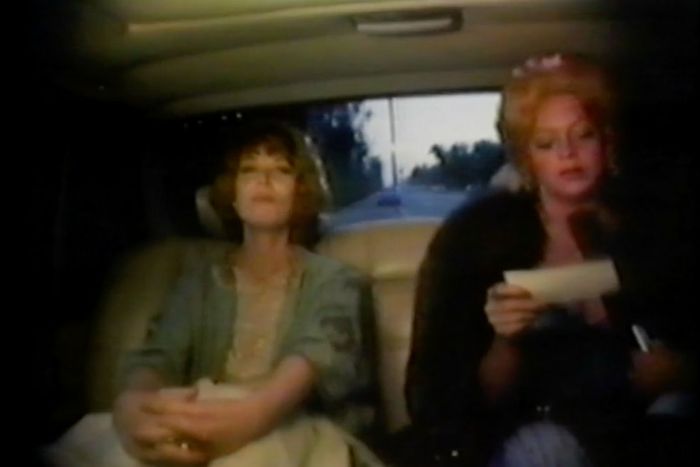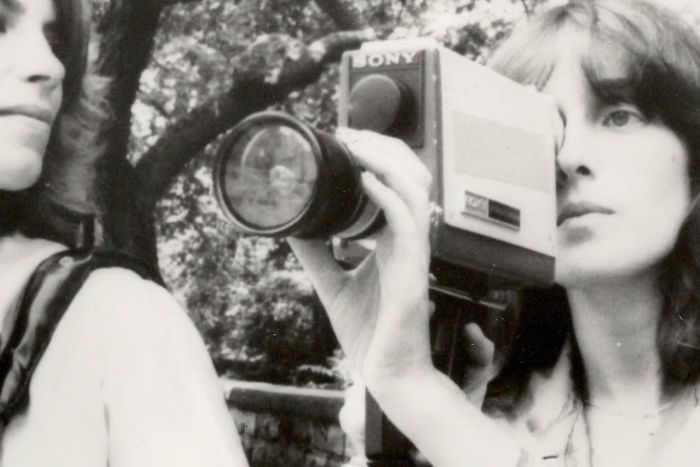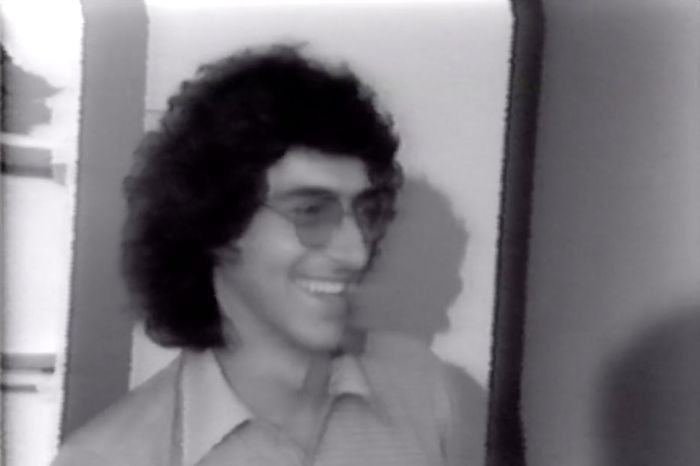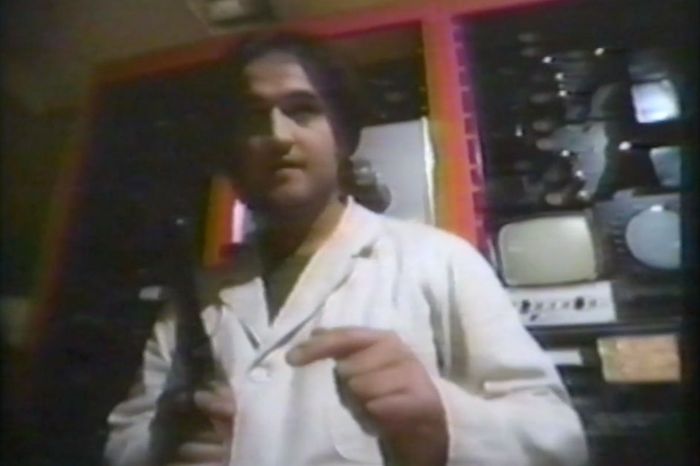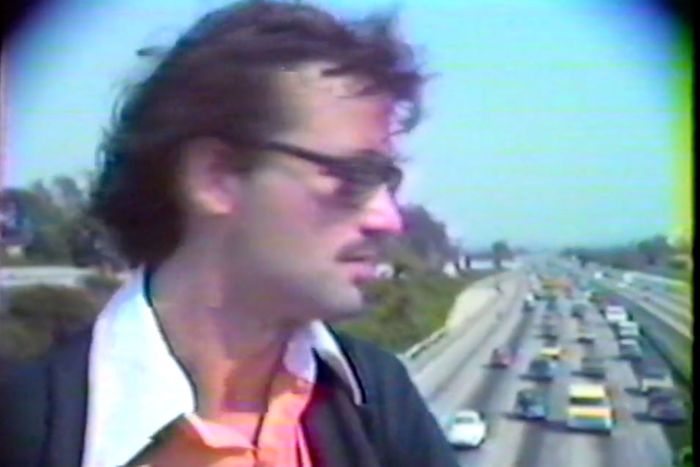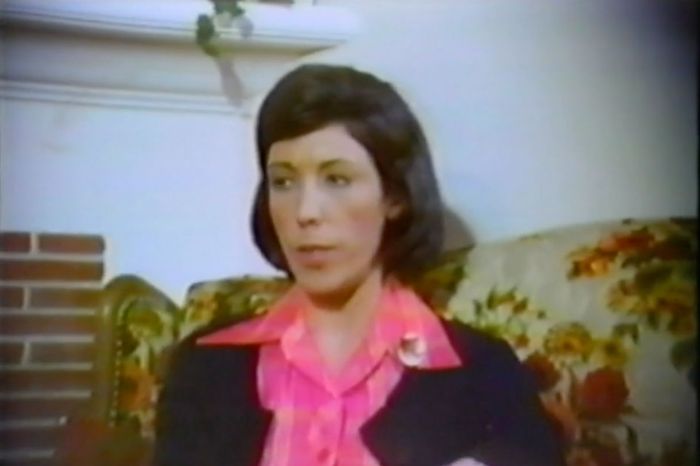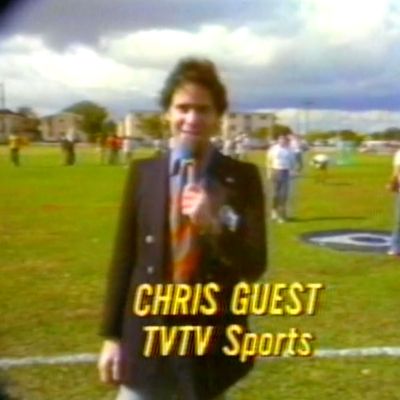
There’s a scene in cinematographer and director Paul Goldsmith’s new documentary TVTV: Video Revolutionaries where a young Bill Murray does public-access-channel correspondent work at an NFL alumni game before the 1976 Super Bowl. He asks sportscaster Phyllis George, “If you had to marry a football player, which one would you marry?” She replies, “That’s a sexist kind of question, isn’t it? I’m not sure if I like that.” Murray agrees and apologizes.
Reminder: This was 1976, when second-wave feminism’s bloom was encouraging, but not enough to see a tête-à-tête like this on television. Definitely not during Super Bowl weekend. The moment was like a beautiful, impromptu hybrid of a Nathan for You bit that turned into a segment on VICE News. Not 30 yards away, a blazered Christopher Guest was doing classically deadpan segment introductions ahead of the same pre-Bowl alumni face-off. “You never know what’s going to happen in these games. They can get a little rough, or they can get boring. It depends what happens.”
Later, footage of Lee Grant and Goldie Hawn joking about the possibility of Grant losing the Best Supporting Actress Oscar for 1975’s Shampoo. “Now watch. After all that, I won’t win. Horseshit. Who wants to be a part of it?” Grant says, with candor seldom seen from celebs at the time. Sure, Johnny Carson got some pretty unexpected one-liners out of his guests, but never in their truly private moments. Oh, then Grant ends up winning, and when she and Hawn are in the car headed home, Grant admits that she can’t wait to get the hell away from the Oscars: “Oh, we’re in the car. We’re leaving, we’re getting out. Wonderful.” She’s saying this publicly even after taking home a statue! That’s hot goss! Somewhere, a young Harvey Levin’s ears must’ve been ringing.
In an ecosystem dominated by the vanilla of broadcast TV, how were these peeks behind the curtain allowed to air, and who the hell was capturing them in the first place?
Why, it was TVTV, of course — the steward for a brand of DIY video that every smartphone or 5-D owner takes for granted today.
Dubbed Top Value Television, TVTV was a guerilla film collective founded in 1972 by Michael Shamberg (producer of many movies and television series, from Matilda and Erin Brockovich to Along Came Polly, Reno 911!, and Django Unchained); Allen Rucker (Emmy-winning documentary writer and author); Tom Weinberg (writer, producer, and founder of video archive company Media Burn); Hudson Marquez (painter and writer); and Megan Williams (Oscar-nominated documentary producer). The group formed in the aftermath of Sony’s 1968 release of the first portable videocassette recorder/camera, commonly known as a “Portapak,” and began creating public-access shows and specials often green-lit by New York’s Rockefeller-funded artist-in-residency program, TV Lab. Think a drier version of Above Average.
Cobbling together funding at a time when CBS, NBC, and ABC camera crews were saddled with Cray-size camera rigs hardwired in to nearby equipment that prevented even a whiff of nimbleness, this rogue group of 20-somethings used the Portapak and a whole lot of gusto to bluff their way into some of the most important halls (and limos) in America. They fought hard for press passes (they had cameras, after all) and shot as they damn well pleased.
Soon after TVTV’s founding in San Francisco, Paul Goldsmith joined the crew as a camera operator. Between then and the group’s disbanding in 1979, he became a key element in the rise and fall of an organization too far ahead of its time. Without him and his documentary, TVTV might’ve ended up to be little more than a Wikipedia entry. Luckily, he’s shared with the world an 80-minute reflection on an all-but-forgotten era that defined the modern digital and television landscapes.
The early years of TVTV saw the collective living and working together in San Francisco, in a communelike home where library books doubled as birthday gifts and access to press passes might’ve trumped routine showers. Clamoring to gain respect as disruptive members of the journalistic elite, the majority of TVTV’s early contributions weren’t comedic. Still, the footage is staggering.
We see TVTV correspondents walking with the usually stoic Henry Kissinger at the 1972 Republican National Convention in Miami, as the then-secretary of State calls the women there “very pleasant.” Not much by today’s batshit D.C. standards, sure, but for the time? From a man like Kissinger? Astounding. Back at the capital, footage shows two TVTV crewers wandering around unescorted inside the Gerald Ford White House, while the rest of the press pool is hearing the president speak in the Rose Garden. In the documentary, founding member Hudson Marquez describes the shtick that allowed TVTV to function as renegades in some of the most secure locations on earth: “[We’d say,] ‘We don’t know anything. Why don’t you show us how you do that?’ It was like we’d never flushed a toilet before.”
From ’72 until ’75, TVTV continued to enjoy support from public-access channels that ranged from WNET in New York to KQED in San Francisco. They began championing human-interest pieces. From In Hiding with FBI-wanted activist and anarchist Abbie Hoffman to an exploration of Creole culture in The Cajun Show, TVTV’s work had a certain arch appeal, an authenticity that showed their subjects as they really were, warts and all. “Today, it would be impossible to come anywhere near the access we were given. Not even close,” Goldsmith says. “On the other hand, a truly talented performer now has the tools to make media anytime, anywhere. I see some very interesting things coming down the pike … and some very scary ones.”
The collective’s no-holds-barred tone didn’t appeal to everyone. In fact, by 1975, there was a growing critique that TVTV was the beneficiary of “checkbook journalism” (modest public-access checks, but still). Simply, the news Establishment had never seen television produced this way, so it rejected them.
Whether ousted by the gatekeepers of journalistic intellectualism, intrigued by the idea of producing pure entertainment, or both, TVTV moved to Los Angeles in ’76, and — in part facilitated by Rucker and Shamberg’s college pal, Harold Ramis — turned their pioneering lenses in a different direction.
In addition to directing some of the most definitively funny work for TVTV, including a WNET-sponsored special called Supervision featuring a young John Belushi, Ramis introduced the TVTV crew to comedy royalty years before they or anyone else knew it.
“Chris [Guest] worked with us because of his similar interest in melding the quirkiness of the real world with a doc-style media,” Goldsmith says. “Harold [Ramis] had been a college roommate of Michael’s — they had written a novel together and were on similar paths. TVTV provided Harold an opportunity to do his first directing. Billy [Murray] joined us because in the first season of SNL they swept up Belushi, Gilda, Chevy, etc., but not Billy. We provided a platform for him to perform, a place to hang out, a couch to sleep on, and $50 a week.”
In the doc, Goldsmith chronicles how a baby-faced Murray ran sound at a poetry reading hosted by Ken Kesey in between helming man-on-the-street gems, like one where he stands over the unstoppable L.A. freeway and describes the different car washes that passing vehicles might have ordered in a sketch called “The World’s Largest Car Wash.” Early glints of Murray’s famed “Cinderella story” rant in Caddyshack are apparent.
In 1976’s docu-special TVTV Looks at the Academy Awards (for Los Angeles’s KCET public-television station), coverage of the nominations feature a cross-legged Steven Spielberg lamenting a lost nomination for Jaws. “I got beat out by Fellini!” Then, when awards night finally comes, the event is intercut with Lily Tomlin (nominated for Nashville) playing an aloof, midwestern housewife, Mrs. Beasley, in what can only be described as a precursor to the kind of interstitial sketches that are now the saving grace of so many dry awards shows. On TVTV’s final check-in with Beasley, she’s asleep. The party’s not over, but she doesn’t give a shit — the Oscars are boring. No one had ever deigned criticize Hollywood’s Big Night before, and it was perfect.
Also in ’76, TVTV covered the Super Bowl (after Bill Murray’s aforementioned pregame sideline shtick) where correspondents ignored coaches and QBs in favor of sneaking a locker-room look at Cowboys tight end Jean Fugett’s team playbook. (Seriously, they filmed the plays and put them on national television.) Then they gave Steelers legend Lynn Swann his own Portapak to do as he damn well pleased in man’s earliest version of a social-media takeover. Hell, TVTV even interviewed players’ wives poolside decades before VH1’s Basketball Wives was a glint in Viacom executives’ eyes.
“I suppose the first reality TV was shot in 16 mm film and was called ‘cinéma vérité.’ That’s what I loved to do before I joined TVTV,” Goldsmith says. “But one of the tenets of cinéma vérité was that it was objective — the filmmakers didn’t have any effect; they were like a fly on the wall. What nonsense. TVTV was the first to have the journalists/filmmakers be part of the show. Anyone could talk — we became characters in the scene.”
By 1979, TVTV had gone fully Hollywood with The TVTV Show, an NBC variety pilot that never aired and landed the collective’s members $50,000 in debt. Not long before, “Billy” Murray got scooped up by SNL, and the rest is history. Well, at least for Bill, John, Harold, Chris, and all of the other famous faces TVTV met during its rise and fall. For TVTV’s founding team, Paul Goldsmith, and dozens of other members, the movement had ended, but not without making a mammoth impact on modern entertainment.
“I learned how to write comedy from TVTV,” founding member Allen Rucker says. “Though the shows were entirely unscripted, when I began to work with skilled comedians like Martin Mull, Harry Shearer, Fred Willard, and others in the 1980s, we had similar sensibilities coming from different directions. Bending reality was the style.”
I ask Rucker if he thinks a collective like TVTV could exist today. His answer surprises me. “People making film or video today usually go through film school where they are indoctrinated about specific roles like director, writer, etc.,” he says. “I went to film school at Stanford, but most early TVTVers were journalists or artists who didn’t care about traditional filmmaking structure.”
He’s wrong. DIY video is huge today. As Goldsmith mentioned, anyone with an iPhone can shoot anything (sometimes unfortunately) and upload it to YouTube. If anything, film school seems like a bigger waste of time now than it ever has, at least for anyone with vision and a little chutzpah. What was Rucker talking about? Then, he finishes his thought: “They just wanted to make video that was 100 percent alive and were self-taught.”
Rucker thought his DIY revolution had passed today’s filmmakers by, when in fact it has shaped it. He didn’t realize that while TVTV stopped in 1979, his work — and the work of Goldsmith and all his other cohorts — allowed the rest of us film-school-skippers to get started. In so many ways, TVTV is the history of this very moment in entertainment, and everything that’s led to it.
TVTV co-editor and TVTV member Wendy Apple reflects on why she joined the collective so many years ago: “There is something wrong with this broadcast medium. It’s a slave to the medium. It’s there to sell stuff. And we want to see other stories. We want the camera to be pointing in other ways, and we’re gonna take you on, and I was so naïve that I believed we could win.”
Flash-forward to 2018, where streamers like Netflix, Hulu, and Amazon buck the ad-funded model completely, networks like Viceland do … whatever the hell they please, 30 for 30 documentaries obliterate the veneer of pro sports, and Oscar hosts are paid to mock the very affair they’re leading.
Maybe Wendy wasn’t so naïve after all.
TVTV: Video Revolutionaries is now available on iTunes.


